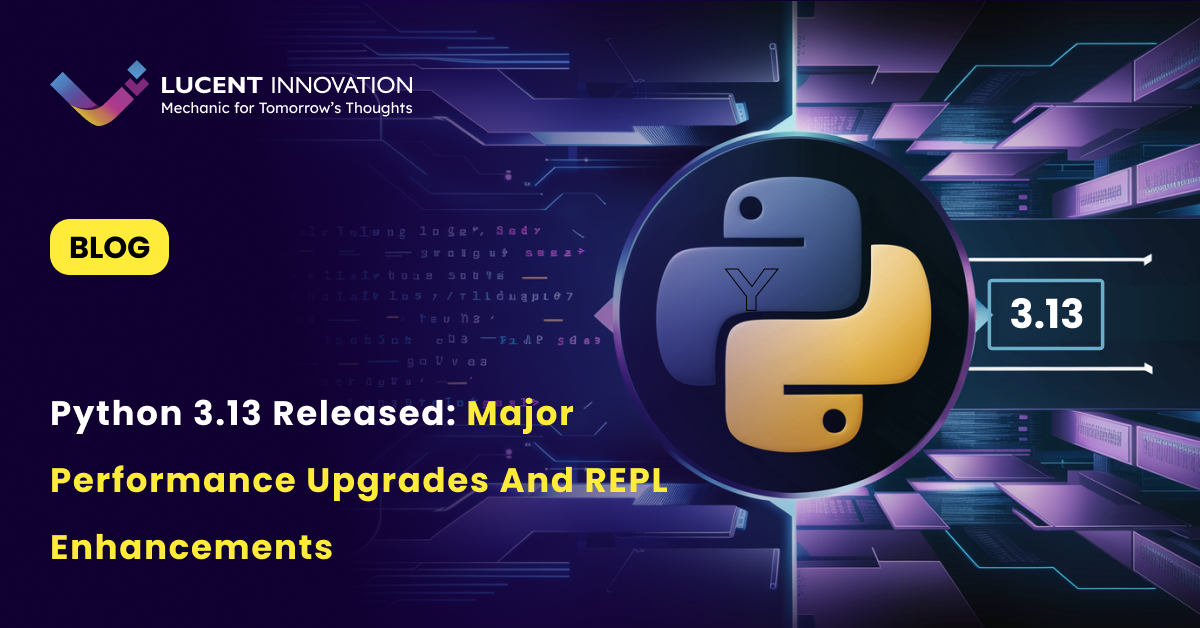What's New in Python 3.13: Performance Improvements and Python REPL
 Lucy
LucyTable of contents
- Introduction
- Some of the notable latest Python 3.13 features are:
- What’s new in Python?
- Python 3.13: New Features and Improvements
- 1. A Better Interactive Interpreter
- 2. Experimental Just-In-Time (JIT) Compilation
- 3. Experimental Free-Threaded CPython
- 4. Improved Error Reporting and Guidance
- 5. Interactive Shell Makeover (New REPL)
- 6. Incremental Garbage Collection
- 7. Improved Error Reporting and Guidance
- 8. Memory Optimization for Docstrings
- 9. Performance Enhancements in Modules
- 10. Removal of Deprecated Modules ("Dead Batteries")
- Should you upgrade to Python 3.13?
- Conclusion:

Introduction
Python is a web programming language with a clear syntax and is very easy to learn. It has a lot of uses and applications like web development, game development and desktop GUI, it is very popular in data science, AI and ML and has an awesome community. It is essential to stay updated on the latest Python releases as it helps with improving development experience, enhancing the performance of your applications and helping with bug fixes. Python 3.13 was released on October 7th'2024.
Today we will be talking about the release of the latest Python 3.13 and what major improvements are made. The upgrades are focused on refining developer experience and optimizing your processes.

Some of the notable latest Python 3.13 features are:
Better REPL: Have a more communicative and informative REPL experience with multi-line editing, color support, and colorized exception tracebacks.
Experimental Free-Threaded Mode: Gain benefits from enhanced concurrency and performance on multi-core systems.
Preliminary JIT Compiler: Take advantage of the groundwork laid for a future JIT compiler, giving better performance improvements.
Improved Type System: Use type defaults, type narrowing annotations, and deprecation markers for more meaningful code maintenance.
How These Features Benefit Developers and Businesses?
Growing Productivity: The efficient REPL and better type system can help developers write code more easily and reduce common errors.
Improved Performance: The experimental free-threaded mode and future JIT compiler lead to more performance gains, mainly for computationally intensive tasks.
Better Code Quality: The new type system features can help you write stronger and maintainable code.
Scalability: Staying up to date with the latest Python releases makes sure that your code stays compatible and also gains from any future updates.
All these new updates and features will help developers write more streamlined,eloquent,easily maintained Python code which will help you in moving forward to business success.
What’s new in Python?
Here is the latest review on what are the latest updates and features in Python.
Python 3.13: New Features and Improvements
Python 3.13, set for release on October 7, 2024, brings exciting new features, enhancements, and optimizations. This version builds on Python 3.12 with notable improvements in performance, usability, and functionality. Below is a detailed overview of the key changes introduced in Python 3.13.
1. A Better Interactive Interpreter
Python 3.13 delivers a visually enhanced interactive interpreter, improving user experience through colorized output, tracebacks, and doctest results. The colorization feature can be disabled via environment variables (PYTHON_COLORS and NO_COLOR), offering flexibility based on user preferences.
Additionally, Python 3.12 introduced a basic Just-In-Time (JIT) compiler per PEP 744. Though disabled by default, it shows promise for future performance boosts, with plans for continued development.
2. Experimental Just-In-Time (JIT) Compilation
Python 3.13 introduces an experimental JIT compiler aimed at accelerating Python code execution. This feature translates specialized Tier 1 bytecode into a new Tier 2 Intermediate Representation (IR), which is optimized for machine code execution.
Potential Benefits:
Significant performance gains for specific code sections.
Opportunities for advanced optimizations with bytecode interpretation were previously impossible.
The JIT can be configured via the --enable-experimental-jit option, providing control over its behavior at build and runtime.
3. Experimental Free-Threaded CPython
Python 3.13 introduces free-threaded CPython by allowing the Global Interpreter Lock (GIL) to be disabled with the --disable-gil option. This allows true parallel execution of threads, unlocking the full potential of multi-core processors.
Benefits:
Improved performance for CPU-bound tasks that leverage threading.
Better utilization of modern hardware, ideal for scientific computing and data-heavy workloads.
Note: Extension modules must be updated to support GIL-free operation.
4. Improved Error Reporting and Guidance
Error reporting in Python 3.13 has been enhanced to offer better user guidance:
Colorized Tracebacks: Error messages are now colorized by default, making it easier to identify issues.
Keyword Argument Suggestions: If an incorrect keyword is used, Python will suggest the correct one.
Module Name Conflicts: When a script has the same name as a standard library module, Python provides a detailed error message, recommending renaming to avoid conflicts.
Example:
\>>> sys.version_info
Traceback (most recent call last):
File "<stdin>", line 1, in <module>
NameError: name 'sys' is not defined. Did you forget to import 'sys'?
5. Interactive Shell Makeover (New REPL)
The REPL (Read-Eval-Print Loop) gets a major overhaul in Python 3.13, providing a more intuitive and user-friendly interactive experience.
Key Features:
Colorized Output (Linux/macOS): Easier to read code and error messages (not yet available on Windows).
Integrated Help (F1): Access documentation directly from the REPL.
Command History Navigation (F2): Quickly browse through command history.
Block Paste Mode (F3): Simplifies pasting multi-line code.
Simplified Exit: Just type exit or quit to leave the REPL.
These enhancements streamline interactive development, making it more efficient and accessible.
6. Incremental Garbage Collection
Python 3.13 continues to improve memory management with incremental garbage collection. This feature reduces pause times during garbage collection, which is particularly beneficial for applications that involve frequent memory allocation and deallocation.
# Python 3.12
import gc
gc.isincremental() # Returns True
7. Improved Error Reporting and Guidance
Error tracking in Python has been improved in the latest version. The interpreter now colorizes error messages when displaying tracebacks by default. In another feature, the error message suggests the correct keyword argument, if an incorrect keyword was passed to a function. Sometimes, when a script has the same name as a standard library module, Python now provides a detailed error message and suggests renaming the module for better understanding.
8. Memory Optimization for Docstrings
To reduce memory usage, Python 3.13 optimizes how docstrings are stored. Previously, leading indentation in docstrings contributed to larger bytecode files and increased memory consumption. The new optimization automatically strips unnecessary spaces, leading to:
Smaller bytecode files.
Reduced memory usage for projects with extensive docstrings.
9. Performance Enhancements in Modules
Several performance improvements have been made across different Python modules:
Faster textwrap.indent(): Now approximately 30% faster for large inputs, improving text manipulation efficiency.
Improved Import Times: Import times for standard libraries, like typing, have been reduced by optimizing dependencies.
10. Removal of Deprecated Modules ("Dead Batteries")
Python 3.13 continues the removal of deprecated modules, making the codebase cleaner, more secure, and easier to maintain.
Why Remove Deprecated Modules?
It prevents developers from unknowingly using outdated functionalities.
Encourages modern practices and the use of better-supported alternatives.
Benefits:
Cleaner Codebase: Developers can write more modern and secure code.
Fewer Security Risks: Deprecated modules are often less secure and unmaintained.
Should you upgrade to Python 3.13?
Well, the answer is based on your specific requirements. You should upgrade if you want better performance and improved functionalities. You will get better compatibility with other libraries and frameworks and the main point is it will protect your applications with the latest security patches.
Factors you need to Consider:
Project Needs: The requirements of your project objectives and goals should match with the latest features.
Compatibility and Testing: You need to test your code for Python 3.13 to detect and look at any compatibility problems.
Team Collaboration: You should guide your team to the new version and make sure they are ready and updated.
Production Environment: You should acknowledge the effect of this update on your production environment and the testing and migration resources.
Conclusion:
As we explore the most recent highlights of Python 3.13, the important consideration of whether or not to update are your unique project requirements.
The new capabilities seen above are:
Improvements have been made to the Python interactive interpreter (REPL).
Updated error messages to help you in resolving common issues
Python is free-threaded now that the global interpreter lock (GIL) has been removed.
Utilizing a prototype Just-In-Time (JIT) compiler
A few minor modifications to the static type of system in Python
So, there are benefits to upgrading to Python 3.13 if you want all these added capabilities
Hire Python Developers from Lucent Innovation to put all these new capabilities into practice and expand your projects using optimized code and the latest technologies.
Subscribe to my newsletter
Read articles from Lucy directly inside your inbox. Subscribe to the newsletter, and don't miss out.
Written by
